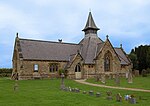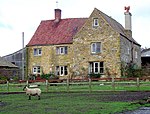Balk, North Yorkshire
Civil parishes in North YorkshireNorth Yorkshire geography stubsUse British English from March 2020Villages in North Yorkshire

Balk is a hamlet and civil parish in the former Hambleton District of North Yorkshire, England, just east of Thirsk. In the 2001 census the parish had a population of 48. The population of the parish was estimated at 60 in 2013. The parish shares a grouped parish council with the adjacent parish of Bagby. The moated grange at grid reference SE47718083 is a scheduled ancient monument.
Excerpt from the Wikipedia article Balk, North Yorkshire (License: CC BY-SA 3.0, Authors, Images).Balk, North Yorkshire
Geographical coordinates (GPS) Address Nearby Places Show on map
Geographical coordinates (GPS)
| Latitude | Longitude |
|---|---|
| N 54.2222 ° | E -1.26931 ° |
Address
YO7 2AH
England, United Kingdom
Open on Google Maps










